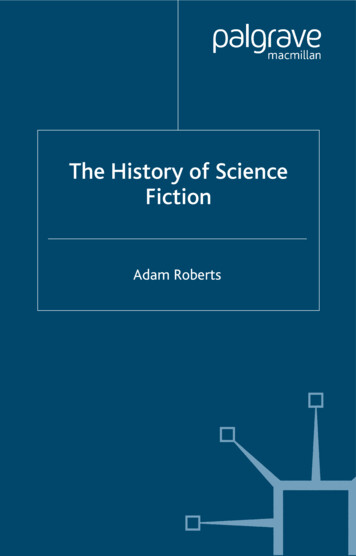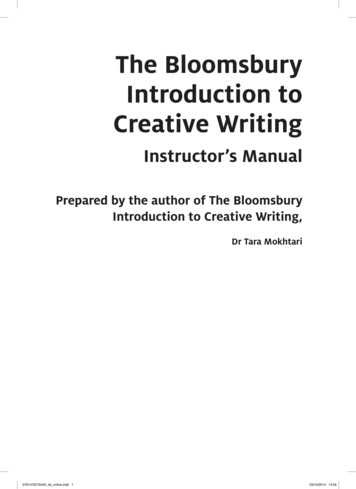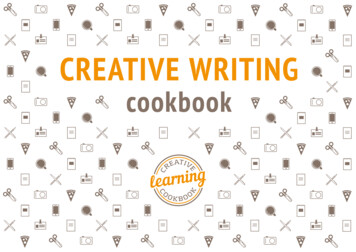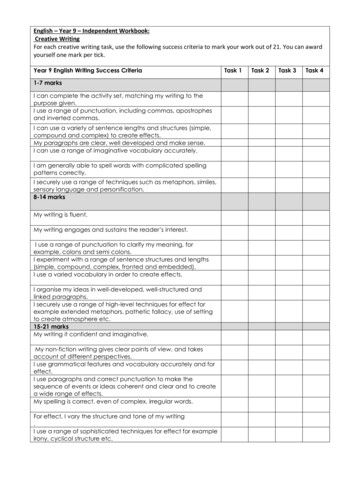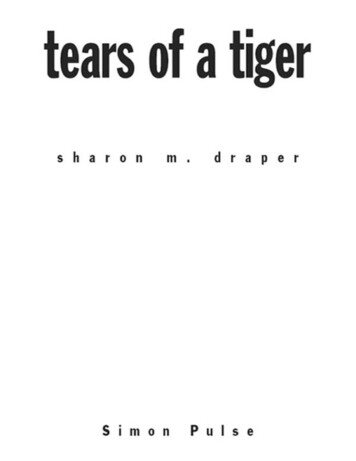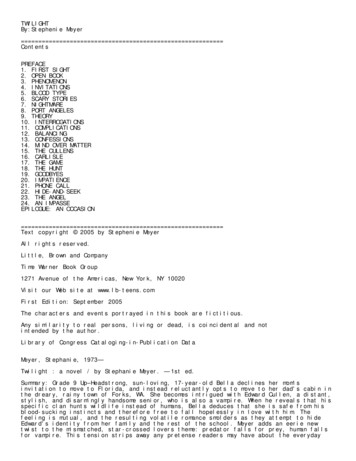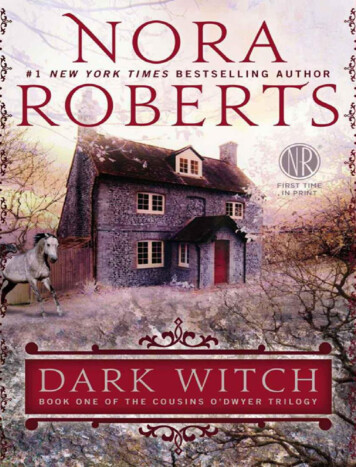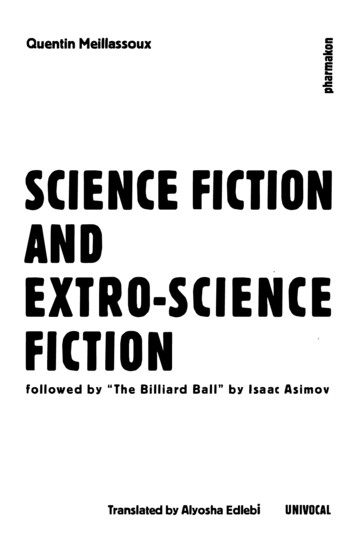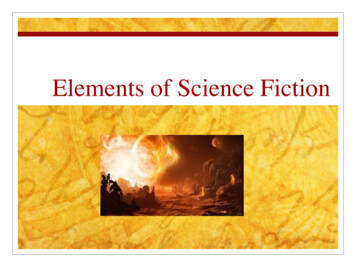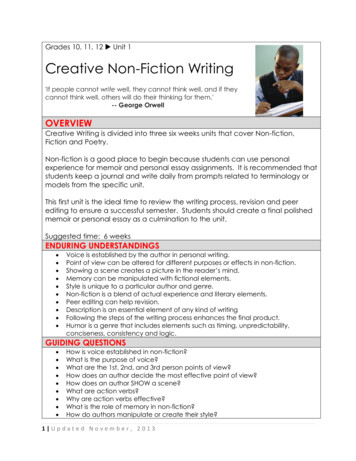
Transcription
Grades 10, 11, 12 Unit 1Creative Non-Fiction Writing'If people cannot write well, they cannot think well, and if theycannot think well, others will do their thinking for them.'-- George OrwellOVERVIEWCreative Writing is divided into three six weeks units that cover Non-fiction,Fiction and Poetry.Non-fiction is a good place to begin because students can use personalexperience for memoir and personal essay assignments. It is recommended thatstudents keep a journal and write daily from prompts related to terminology ormodels from the specific unit.This first unit is the ideal time to review the writing process, revision and peerediting to ensure a successful semester. Students should create a final polishedmemoir or personal essay as a culmination to the unit.Suggested time: 6 weeksENDURING UNDERSTANDINGS Voice is established by the author in personal writing.Point of view can be altered for different purposes or effects in non-fiction.Showing a scene creates a picture in the reader’s mind.Memory can be manipulated with fictional elements.Style is unique to a particular author and genre.Non-fiction is a blend of actual experience and literary elements.Peer editing can help revision.Description is an essential element of any kind of writingFollowing the steps of the writing process enhances the final product.Humor is a genre that includes elements such as timing, unpredictability,conciseness, consistency and logic.GUIDING QUESTIONS How is voice established in non-fiction?What is the purpose of voice?What are the 1st, 2nd, and 3rd person points of view?How does an author decide the most effective point of view?How does an author SHOW a scene?What are action verbs?Why are action verbs effective?What is the role of memory in non-fiction?How do authors manipulate or create their style?1 Updated November, 2013
What is non-fiction?What are the different forms of non-fiction?What are the steps of the writing process?What is the purpose of peer editing?What makes a good description?What are the elements of humorous writing?STUDENTS WILL KNOW AND UNDERSTAND BrainstormingstrategiesFiction vs. Non-fictionImplicit themes,explicit themesMemoirMemoryPeer editing—praising, questioning,making suggestionsPersonal essayPoint of viewRevising—adding,deleting, reordering,substituting andreformulatingShow vs. TellStyleToneTransitionsVoiceWriting process What voice isThe steps of the writing processBrainstorming strategiesThe difference between fiction and non-fictionWhat style isWhat point of view isWhat tone isWhat memoir isWhat personal essay isHow to peer editWhat implicit and explicit themes areHow to use transitionsRevising includes adding, deleting, reordering,substituting and reformulatingPeer editing includes praising, questioning andmaking suggestionsFollowing the steps of the writing processenhances writingSTUDENTS WILL BE ABLE TOReading: Informational TextKey Ideas and Details RI.9-10.1 RI.11-12.1 RI.9-10.2 RI.11-12.2Cite strong and thorough textual evidence to support analysis of whatthe text says explicitly as well as inferences drawn from the text.Cite strong and thorough textual evidence to support analysis of whatthe text says explicitly as well as inferences drawn from the text,including determining where the text leaves matters uncertain.Determine a central idea of a text and analyze its development overthe course of the text, including how it emerges and is shaped andrefined by specific details; provide an objective summary of the text.Determine two or more central ideas of a text and analyze theirdevelopment over the course of the text, including how they interactand build on one another to provide a complex analysis; provide anobjective summary of the text.Range of Reading and Level of Text Complexity2 Updated November, 2013
RI.9-10.10RI.11-12.10By the end of grade 9, read and comprehend literary nonfiction in thegrades 9–10 text complexity band proficiently, with scaffolding asneeded at the high end of the range.By the end of grade 10, read and comprehend literary nonfiction at thehigh end of the grades 9–10 text complexity band independently andproficiently.By the end of grade 11, read and comprehend literary nonfiction in thegrades 11–CCR text complexity band proficiently, with scaffolding asneeded at the high end of the range.By the end of grade 12, read and comprehend literary nonfiction at thehigh end of the grades 11–CCR text complexity band independentlyand proficiently.WritingText Types and Purposes W.9-10.3W.11-12.3 W.9-10.3.a W.11-12.3.a W.9-10.3.bW.11-12.3.b W.9-10.3.c W.11-12.3.c W.9-10.3.dW.11-12.3.d W.9-10.3.eW.11-12.3.eWrite narratives to develop real or imagined experiences or events usingeffective technique, well-chosen details, and well-structured eventsequences.Engage and orient the reader by setting out a problem, situation, orobservation, establishing one or multiple point(s) of view, andintroducing a narrator and/or characters; create a smooth progressionof experiences or events.Engage and orient the reader by setting out a problem, situation, orobservation and its significance, establishing one or multiple point(s) ofview, and introducing a narrator and/or characters; create a smoothprogression of experiences or events.Use narrative techniques, such as dialogue, pacing, description,reflection, and multiple plot lines, to develop experiences, events,and/or characters.Use a variety of techniques to sequence events so that they build onone another to create a coherent whole.Use a variety of techniques to sequence events so that they build onone another to create a coherent whole and build toward a particulartone and outcome (e.g., a sense of mystery, suspense, growth, orresolution).Use precise words and phrases, telling details, and sensory language toconvey a vivid picture of the experiences, events, setting, and/orcharacters.Provide a conclusion that follows from and reflects on what isexperienced, observed, or resolved over the course of the narrative.Production and Distribution of Writing W.9-10.4W.11-12.4Produce clear and coherent writing in which the development,organization, and style are appropriate to task, purpose, and audience.3 Updated November, 2013
W.9-10.5W.11-12.5 W.9-10.6 W.11-12.6(Grade-specific expectations for writing types are defined in standards1–3 above.)Develop and strengthen writing as needed by planning, revising, editing,rewriting, or trying a new approach, focusing on addressing what is mostsignificant for a specific purpose and audience.Use technology, including the Internet, to produce, publish, and updateindividual or shared writing products, taking advantage of technology’scapacity to link to other information and to display information flexiblyand dynamically.Use technology, including the Internet, to produce, publish, and updateindividual or shared writing products in response to ongoing feedback,including new arguments or information.Range of Writing W.9-10.10 W.11-12.10Write routinely over extended time frames (time for research, reflection,and revision) and shorter time frames (a single sitting or a day or two) fora range of tasks, purposes, and audiences.Write routinely over extended time frames (time for research, reflection,and revision) and shorter time frames (a single sitting or a day or two) fora range of tasks, purposes.LanguageConventions of Standard English L.9-10.1 L.11-12.1L.9-10.1.aL.11-12.1.a L.9-10.2L.11-12.2 Demonstrate command of the conventions of standard Englishgrammar and usage when writing or speaking.Use parallel structure.*Apply the understanding that usage is a matter of convention, canchange over time, and is sometimes contested.Demonstrate command of the conventions of standard Englishcapitalization, punctuation, and spelling when writing.Knowledge of Language L.9-10.3L.11-12.3 Apply knowledge of language to understand how language functions indifferent contexts, to make effective choices for meaning or style, andto comprehend more fully when reading or listening.SUGGESTED WORKSADOPTED RESOURCES On Writing Well by William ZinsserRECOMMENDED RESOURCES (May vary by building):Nonfiction: “Camping Out” by Ernest /a/campinghemingway.htm Dave Barry Columns: http://www.davebarry.com/misccol/misccol.htm “First Bend on the Baro” by Richard Bangs “Gifts from the Genetic Pool” by Susan G Falk “How to Become a Writer” by Lorrie riemooore.html4 Updated November, 2013
“My Hands” by Barry Lopez“My Horse” by Barry Lopez“Neither Here Nor There” by Aimee O’Leary“Picking Cotton” from I Know Why the Caged Bird Sings by Maya icking Cotton.pdf“Stop the Clock” by Amy Wu:http://www2.d125.org/ rtompson/StoptheClock.pdf (See copyright notice.)“Taste” by,J. Kingston Pierce“The Explorer’s Lesson” by L. F. Willard,“The Inheritance of Tools” by Scott Russell Sanders“The Lean and Hungry Look” by Suzanne Britt ession cchs sess:42F94CA6029d93992DVKi4165620“Winter Lights” by Roger ticle/0,9171,1101980216138598,00.html“Yearbook Signing Day” by Dempsey, ChrisZinsser, William “Writing About Yourself: The Memoir” from On Writing WellSAMPLE ACTIVITIES AND ASSESSMENTSACTIVITIES1. ANALYSIS OF NON-FICTION (RI.9-10.1, RI.11-12.1): After viewing the LearnZillionlesson: LearnZillion: Close reading informational text, President Lincoln’s SecondInaugural Address, students will apply what they have learned to analyze one ofthe following non-fiction models: letters, memoirs, personal essay, nd-inaugural-address2. EFFECTIVE VERBS (L.9-10.3, L.11-12.3): Compare effectiveness of verbs in differentpassages: “Effective Writing”: -writing-13815989(Good review of using verbs to strengthen a clause.)3. SUMMARY (RI.9-10.10, RI.9-10.2, RI.11-12.10, RI.11-12.2): Read and summarizeWilliam Zinsser’s “Writing About Yourself: The Memoir” from On Writing Well.4. WRITING A MEMOIR (W.9-10.3, W.9-10.3.a, W.9-10.3.b, W.9-10.3.c, W.9-10.3.d, W.910.3.e, W.9-10.4, W.9-10.5, W.9-10.6, W.11-12.3, W.11-12.3.a, W.11-12.3.b, W.1112.3.c, W.11-12.3.d, W.11-12.3.e, W.11-12.4, W.11-12.5, W.11-12.6): Read or watcha few of the examples of memoirs listed below. Then memorable times, events,and/or experiences in your life and write your memoir based on those. Writing Memoir: http://www.csun.edu/ hflrc001/fall09/sample-memoirs.html(This site has links to several memoirs written by high school and collegestudents.) Center for Digital Story Telling: http://storycenter.org/ (Click on “Stories.”Then click on a category to hear the memoir from that category.)5 Updated November, 2013
The Center for Digital Story ry/videos?shelf index 5&sort dd&view 1&tag id “The PBS NewsHour: Carlos Eire: A search?Ntt memoir&N 18343“The PBS NewsHour: Dorothy Height: A search?Ntt memoir&N 183435. WRITING A PERSONAL NARRATIVE (W.9-10.3, W.9-10.3.a, W.9-10.3.b, W.9-10.3.c,W.9-10.3.d, W.9-10.3.e, W.9-10.4, W.9-10.5, W.9-10.6, W.11-12.3, W.11-12.3.a, W.1112.3.b, W.11-12.3.c, W.11-12.3.d, W.11-12.3.e, W.11-12.4, W.11-12.5, W.11-12.6):Write a personal narrative. “Memoir vs. Personal Narrative”: http://youtu.be/E OO5FmaiRQ “What is the Difference Between a Memoir & Personal tml6. SHORT WRITING PIECES (W.9-10.3, W.9-10.3.a, W.9-10.3.b, W.9-10.3.c, W.9-10.3.d,W.9-10.3.e, W.9-10.4, W.9-10.5, W.9-10.6, W.9-10.10, W.11-12.3, W.11-12.3.a, W.1112.3.b, W.11-12.3.c, W.11-12.3.d, W.11-12.3.e, W.11-12.4, W.11-12.5, W.11-12.6):Write and share short pieces in journal from prompts: descriptions, memories,dreams, imitations. These Journal Writing Prompts Will Encourage Kids to Develop TheirComposition Skills: rompts.html#1 10 Ideas for Descriptive Writing: tive-writing-ideas7. NO LINKING VERBS (L.9-10.3, L.11-12.3): Write a story, paragraph or certainnumber of words using no linking verbs to vary word choice.8. IMITATION IS THE HIGHEST FORM OF FLATTERY (W.9-10.10, L.9-10.1, L.9-10.1.a, L.910.2, W.11-12.10, L.11-12.1, L.11-12.1.a, L.11-12.2): Imitate style of other authors. Beyond Primer Prose: “Two Ways to Imitate the urce/17929. LETTER WRITING (W.9-10.10, W.11-12.10): Write letters to self and others for avariety of purpose and audiences.END OF SEMESTER PERFORMANCE ASSESSMENT (Scroll to end of document.)6 Updated November, 2013
Grades 10, 11, 12 Unit 2Poetry as a Writing Style'I wish our clever young poets would remember my homely definitionsof prose and poetry; that is prose; words in their best order; - poetry;the best words in the best order.'-- S. T. ColeridgeOVERVIEWDuring the poetry unit students begin to explore essential elements of poetry.Students should be exposed to a variety of models and continue to use theirjournals to respond to prompts that allow them to experiment with different kindsof poetry and different aspects – sound, line, image, etc. It is important forstudents to share these journals often. As a culminating activity, students cansubmit polished poems that have been through the writing process includingpeer editing and revision.Suggested time: 6 weeksENDURING UNDERSTANDINGS Sounds are an essential element of poetry because poetry uses rhythm andrhyme.Poetry creates visual images using figurative language.There is more versatility in the structure of poetry than prose because poetry doesnot have to follow specific rules.The main difference between poetry and prose is structure.Voice is unique to individual pieces of writing.GUIDING QUESTIONS How is voice established in poetry?What is the purpose of voice?What is voice?How is meter used to establish rhythm?How do poets manipulate line to emphasize rhythm or meaning?What are the different types of rhyme?What are alliteration, assonance, consonance, and repetition?In what ways can sound be manipulated?How is meter used to establish rhythm?How does figurative language enhance poetry?What is metaphor, simile and personification?How are images created in poetry?What is free verse?How is poetry different than prose?What is a stanza?What is the form of a sonnet?7 Updated November, 2013
STUDENTS WILL KNOW AND UNDERSTAND AlliterationAssonanceConsonanceContentDividing Lines Of Poetry For EffectEnd-StoppedEnjambed/EnjambmentFigurative LanguageFigurative LanguageFormForms Of PoetryFree VerseImageRhythmSoundStresses And Unstressed SyllablesStructureVoiceVoice What voice isThe different forms of poetryWhat closed, endstopped andenjambed lines of poetry areWhat an image isWhat the devices of sound are –alliteration, assonance, consonanceWhat the structure of poetry isHow rhythm is established withstressed and unstressed syllablesWhat stressed and unstressed syllablesareWhat figurative language isHow to divide lines of poetry foreffectWhat free verse isSTUDENTS WILL BE ABLE TOReading: LiteratureKey Ideas and Details RL.9-10.2 RL.11-12.2Determine a theme or central idea of a text and analyze in detail itsdevelopment over the course of the text, including how it emerges and isshaped and refined by specific details; provide an objective summary ofthe text.Determine two or more themes or central ideas of a text and analyzetheir development over the course of the text, including how theyinteract and build on one another to produce a complex account;provide an objective summary of the text.Integration of Knowledge and Ideas RL.9-10.7 RL.11-12.7Analyze the representation of a subject or a key scene in two differentartistic mediums, including what is emphasized or absent in eachtreatment (e.g., Auden’s “Musée des Beaux Arts” and Breughel’sLandscape with the Fall of Icarus).Analyze multiple interpretations of a story, drama, or poem (e.g.,recorded or live production of a play or recorded novel or poetry),evaluating how each version interprets the source text. (Include at leastone play by Shakespeare and one play by an American dramatist.)WritingText Types and Purposes W.9-10.3W.11-12.3Write narratives to develop real or imagined experiences or events usingeffective technique, well-chosen details, and well-structured eventsequences.8 Updated November, 2013
W.9-10.3.a W.11-12.3.a W.9-10.3.bW.11-12.3.b W.9-10.3.c W.11-12.3.c W.9-10.3.dW.11-12.3.d W.9-10.3.eW.11-12.3.eEngage and orient the reader by setting out a problem, situation, orobservation, establishing one or multiple point(s) of view, and introducinga narrator and/or characters; create a smooth progression ofexperiences or events.Engage and orient the reader by setting out a problem, situation, orobservation and its significance, establishing one or multiple point(s) ofview, and introducing a narrator and/or characters; create a smoothprogression of experiences or events.Use narrative techniques, such as dialogue, pacing, description,reflection, and multiple plot lines, to develop experiences, events, and/orcharacters.Use a variety of techniques to sequence events so that they build on oneanother to create a coherent whole.Use a variety of techniques to sequence events so that they build on oneanother to create a coherent whole and build toward a particular toneand outcome (e.g., a sense of mystery, suspense, growth, or resolution).Use precise words and phrases, telling details, and sensory language toconvey a vivid picture of the experiences, events, setting, and/orcharacters.Provide a conclusion that follows from and reflects on what isexperienced, observed, or resolved over the course of the narrative.Production and Distribution of Writing W.9-10.4W.11-12.4 W.9-10.5W.11-12.5 W.9-10.6 W.11-12.6Produce clear and coherent writing in which the development,organization, and style are appropriate to task, purpose, and audience.(Grade-specific expectations for writing types are defined in standards 1–3 above.)Develop and strengthen writing as needed by planning, revising, editing,rewriting, or trying a new approach, focusing on addressing what is mostsignificant for a specific purpose and audience.Use technology, including the Internet, to produce, publish, and updateindividual or shared writing products, taking advantage of technology’scapacity to link to other information and to display information flexiblyand dynamically.Use technology, including the Internet, to produce, publish, and updateindividual or shared writing products in response to ongoing feedback,including new arguments or information.Range of Writing W.9-10.10 W.11-12.10Write routinely over extended time frames (time for research, reflection,and revision) and shorter time frames (a single sitting or a day or two) fora range of tasks, purposes, and audiences.Write routinely over extended time frames (time for research, reflection,and revision) and shorter time frames (a single sitting or a day or two) fora range of tasks, purposes.9 Updated November, 2013
Speaking and ListeningComprehension and Collaboration SL.9-10.1 SL.11-12.1 SL.9-10.1.aSL.11-12.1.a Initiate and participate effectively in a range of collaborative discussions(one-on-one, in groups, and teacher-led) with diverse partners on grades9–10 topics, texts, and issues, building on others’ ideas and expressingtheir own clearly and persuasively.Initiate and participate effectively in a range of collaborative discussions(one-on-one, in groups, and teacher-led) with diverse partners on grades11–12 topics, texts, and issues, building on others’ ideas and expressingtheir own clearly and persuasively.Come to discussions prepared, having read and researched materialunder study; explicitly draw on that preparation by referring to evidencefrom texts and other research on the topic or issue to stimulate athoughtful, well-reasoned exchange of ideas.LanguageVocabulary Acquisition and Use L.9-10.5 Demonstrate understanding of figurative language, word relationships,and nuances in word meanings.SUGGESTED WORKSADOPTED RESOURCES On Writing Well by William ZinsserRECOMMENDED RESOURCES (May vary by building):Novel Scars by Peter MeinkePoems “Ask Me” by William Stafford: http://www.poemhunter.com/poem/ask-me/ “Cobb Would Have Caught It” by Robert Fitzgerald:http://writing.upenn.edu/ afilreis/88/prokosch-baseball.html “Do Not Go Gentle Into the Night” by Dylan 5377 “Heavyweight” by Van Ingram “Introduction to Poetry” by Billy 6 “Latin Night at the Pawnshop” by Martin spada/ “Look Here” by Pamela Alexander: “Name of Horses” by Donald Hall: http://www.poemhunter.com/poem/nameof-horses/ “Oranges” by Gary Soto: http://www.akoot.com/garysoto10.html “Poetry is the Art of Not Succeeding” by Joe Salerno:http://flannelowl.tumblr.com/post/99571538 “Sun” by Gary Soto10 U p d a t e d N o v e m b e r , 2 0 1 3
“The Eye” by Michael azine/browse/106/4#!/20597425“The Poet” by Jane Hirschfield“The Tragedy of Hats” by Clarinda zine/poem/29856“What I Do” by Ellery Akers“What the Living Do” by Marie 78“Why I Will Not Get Out of Bed” by James Tate: http://inpoems.tumblr.com/(Scroll down.)“Yellow” by Charles er.com/fiction/poetry/search“How to Write a Rotten Poem with Almost No Effort” by Richard /course/general assignment?course id 150985&assign id 1582851“Poetry and the Writing Standards” by Jan Burkins and Kim e-writing-standards/ (A piecethat discusses poetry in relation to Common Core standards.)SAMPLE ACTIVITIES AND ASSESSMENTSACTIVITIES1. THEMES OF POETRY (RL.9-10.2, SL.9-10.1, SL.9-10.1.a, RL.11-12.2, SL.11-12.1, SL.1112.1.a): Read various models. In a small group discuss the themes of severalpoems. Share ideas with the entire class. “Themes of hemes Of Poetry.html2. THEMES IN POETRY (W.9-10.3, W.9-10.3.a, W.9-10.3.b, W.9-10.3.c, W.9-10.3.d, W.910.3.e, W.9-10.4, W.9-10.5, W.9-10.6, W.9-10.10, W.11-12.3, W.11-12.3.a, W.1112.3.b, W.11-12.3.c, W.11-12.3.d, W.11-12.3.e, W.11-12.4, W.11-12.5, W.11-12.6,W.11-12.10): Write poems on different themes or have students write at least twopoems on the same topic with different themes. “Poetic Themes”: http://www.poetseers.org/themes/3. IMAGES IN POETRY (RL.9-10.7, W.9-10.3, W.9-10.3.a, W.9-10.3.b, W.9-10.3.c, W.910.3.d, W.9-10.3.e, W.9-10.4, W.9-10.5, W.9-10.6, W.9-10.10, L.9-10.5, RL.11-12.7,W.11-12.3, W.11-12.3.a, W.11-12.3.b, W.11-12.3.c, W.11-12.3.d, W.11-12.3.e, W.1112.4, W.11-12.5, W.11-12.6, W.11-12.10, L.11-12.5): Write a poem focusing on aspecific image or analyze the poems and paintings paired at this website: “Pairing Paintings with Poems” by Jessica airing-paintings-withpoems.html11 U p d a t e d N o v e m b e r , 2 0 1 3
(Section on 4. IMITATING POETIC STYLES (W.9-10.3, W.9-10.3.a, W.9-10.3.b, W.9-10.3.c, W.9-10.3.d,W.9-10.3.e, W.9-10.4, W.9-10.5, W.9-10.6, W.9-10.10, W.11-12.3, W.11-12.3.a, W.1112.3.b, W.11-12.3.c, W.11-12.3.d, W.11-12.3.e, W.11-12.4, W.11-12.5, W.11-12.6,W.11-12.10): Imitate poetic styles. Take a title of a poem and use it as title or firstline of a poem. Literary Parodies: Exploring a Writer’s Style through writer-839.html?tab 1#tabs5. RHYME AND RHYTHM (W.9-10.3, W.9-10.3.a, W.9-10.3.b, W.9-10.3.c, W.9-10.3.d,W.9-10.3.e, W.9-10.4, W.9-10.5, W.9-10.6, W.9-10.10, W.11-12.3, W.11-12.3.a, W.1112.3.b, W.11-12.3.c, W.11-12.3.d, W.11-12.3.e, W.11-12.4, W.11-12.5, W.11-12.6,W.11-12.10): Experiment with rhyme and rhythm: tGuid/851FE8FB-697F4339-9251-5FE30E5F64B7 (Section on Rhyme and Rhythm) Poems for Studying Rhythm and -studying-rhythm-andmeter.html6. POETRY AND PROSE (W.9-10.3, W.9-10.3.a, W.9-10.3.b, W.9-10.3.c, W.9-10.3.d, W.910.3.e, W.9-10.4, W.9-10.5, W.9-10.6, W.9-10.10, W.11-12.3, W.11-12.3.a, W.1112.3.b, W.11-12.3.c, W.11-12.3.d, W.11-12.3.e, W.11-12.4, W.11-12.5, W.11-12.6,W.11-12.10): Compare poetry and prose on the same topic. What is Poetry? Contrasting Poetry and urce-print.html?id 307387. FIGURATIVE LANGUAGE IN POETRY (W.9-10.3, W.9-10.3.a, W.9-10.3.b, W.9-10.3.c,W.9-10.3.d, W.9-10.3.e, W.9-10.4, W.9-10.5, W.9-10.6, W.9-10.10, L.9-10.5, W.11-12.3,W.11-12.3.a, W.11-12.3.b, W.11-12.3.c, W.11-12.3.d, W.11-12.3.e, W.11-12.4, W.1112.5, W.11-12.6, W.11-12.10, L.11-12.5): Create figurative language: metaphors,similes, personification. Examples of Poems Using Figurative es-of-poems-using-figurativelanguage.html8. POETRY AND PROSE (W.9-10.3, W.9-10.3.a, W.9-10.3.b, W.9-10.3.c, W.9-10.3.d, W.910.3.e, W.9-10.4, W.9-10.5, W.9-10.6, W.9-10.10, W.11-12.3, W.11-12.3.a, W.1112.3.b, W.11-12.3.c, W.11-12.3.d, W.11-12.3.e, W.11-12.4, W.11-12.5, W.11-12.6,W.11-12.10): Convert poems in prose form with their line breaks. “Literary Alchemy: Turning Your Prose into icles/by-writinggenre/poetry/literary alchemy turning your prose into poetry12 U p d a t e d N o v e m b e r , 2 0 1 3
9. FORMS OF POETRY (W.9-10.3, W.9-10.3.a, W.9-10.3.b, W.9-10.3.c, W.9-10.3.d, W.910.3.e, W.9-10.4, W.9-10.5, W.9-10.6, W.9-10.10, W.11-12.3, W.11-12.3.a, W.1112.3.b, W.11-12.3.c, W.11-12.3.d, W.11-12.3.e, W.11-12.4, W.11-12.5, W.11-12.6,W.11-12.10): Write poems in different forms: haiku, sonnets, shapes: “Examples of Haiku Poems”: u-poems.html “Sonnet Central”: http://www.sonnets.org/ Shape Poems and /END OF SEMESTER PERFORMANCE ASSESSMENT (Scroll to end of document.)13 U p d a t e d N o v e m b e r , 2 0 1 3
Grades 10, 11, 12 Unit 3Fiction as a Form of CreativeWritingGood fiction creates empathy. A novel takes you somewhere and asks you tolook through the eyes of another person, to live another life.--Barbara KingsolverOVERVIEWDuring the fiction unit students begin to explore essential elements of shortstories, drama, etc. Students should be exposed to a variety of models andcontinue to use their journals to respond to prompts that could eventually leadthem to a completed piece of fiction. It is important for students to share thesejournals often. For the culminating activity, students should submit a short storyor one-act play that has been through the writing process, including peerediting and revision.Suggested time: 6 weeksENDURING UNDERSTANDINGS Characters are developed through direct and indirect methods ofcharacterization.Characters serve different purposes in fiction.Effective characters should exhibit typical, universal and individualcharacteristics.Dialogue develops character in fiction.Dialogue in fiction should mirror natural speech.Narrative time is a device of plot.Plot and structure are the building blocks of narrative.Tone and mood are essential elements of fiction.Characterization influences emotional response of the audience.GUIDING QUESTIONS What methods are used to create characters?How do you develop character directly?How do you develop character indirectly?What purposes do characters serve in fiction?How do you create flat, round, static and dynamic characters?What do all effective characters have in common?What makes characters typical?How do you create a typical character?How do you create a universal character?How do you create an individual character?What is the purpose of dialogue in fiction?How does dialogue develop character?14 U p d a t e d N o v e m b e r , 2 0 1 3
How does dialogue show, not tell action?How should dialogue be written?How is narrative time developed in plot?How is plot developed?What is structure in plot?How is structure in plot developed?What is tone? Mood?How are tone and mood created in fiction?What is the goal of characterization?How does an author get an emotional response from the reader?STUDENTS WILL KNOW AND UNDERSTAND Character—flat, round, static, dynamicClichéDialogue—rules, functionEffective beginningsFlashbackForeshadowingGenre of “short fiction”How to develop a settingIn medias resMoodNarrativeNarrative timePlot and structurePoint of viewPoint of viewReliable narratorSceneSettingShow vs. TellSlow motionStereotypesSummaryTone What voice isThe different forms of poetryWhat closed, endstopped andenjambed lines of poetry areWhat an image isWhat the devices of sound are –alliteration, assonance,consonanceWhat the
Creative Non-Fiction Writing 'If people cannot write well, they cannot think well, and if they cannot think well, others will do their thinking for them.'-- George Orwell OVERVIEW Creative Writing is divided into three six weeks units that cover Non-fiction, Fiction and Poetry. Non-fiction i
